#allegheny mountain ranges
Text
My only real dislike towards the inclusion of Super Mutants in Fallout 76 is a very simple, very petty one.
They didn't keep with the cryptid theme in naming them.
The Allegewi was right there, man!
#fallout#fallout 76#f76#super mutant#cryptid#the cannibalistic giant cryptid was right there#Huntersville is literally right by the Allegheny mountain range!#Otherwise I love them#propane tanks and wheelbarrows as makeshift armor#genuinely really cool
3 notes
·
View notes
Text
From @gaviiadastra
From @gaviiadastra to @womble1
Hello to my wonderful gift recipient! I’m certain this was a gift to me; I got to write my all time favorites. Thank you! I hope you have a wonderful holiday and that you enjoy this story, and special thanks to TAGSS for organizing the exchange this year.
My prompts were:
1. FishTank (Virgil & Gordon) and woodland dappled light.
2. Alan having to deal with life outside the island.
3. Anything christmassy. Who am I kidding, I'll be happy with anything. 😁
___
Along Country Roads
Summary: a place can hold unique memories for different people - sometimes it’s the same one, just different.A/N: I promise, it’s a balanced level of sappiness and brother time with some light h/c. For exact warnings: references to depression and avalanche aftermath, in which I headcanon Virgil was present with Lucille. Gordon’s hydrofoil accident is always in the background. But there’s laughs too, aaaand I’ve continued to use crafty!FishTank as a plot device.
~*~
For as much as Scott fought the GDF for them to have a family holiday, the IR commander sure managed to make himself scarce, Virgil thought bitterly. It was the first time they’d managed to take International Rescue offline for a full week without there being an excuse of a serious injury prompting the decision – a fact that hurt his heart to think about. Still, Virgil awoke to a mostly empty household despite the homely comfort of coffee still warmed and the gentle brush of heat throughout the cabin from the controlled flames stoked in the fireplace.
But, no, that wasn’t necessarily fair to Scott either, and Virgil recognized his sleepiness taking control of his thoughts. He’d known his older brother would need to take some time in DC, and it wasn’t actually all that far to the Capitol. All would be well, as long as Scott’s business was concluded by Christmas, like he’d promised them. It still felt strange to be offline; not knowing what was happening in the rest of the world left an uncomfortable itch that ran through his blood, which was only eased with the knowledge that Eos was still watching, listening, and would alert them if they were needed.
The distance away was exactly why they'd chosen here in the first place - a remote location for the full step back and reset they needed after months of running on exhaustion.
These days, the mountain cabin and its surrounding property belonged to Virgil, even if he still thought of it as one of their family’s winter homes. It was only after their mother’s death that they started vacationing here in Appalachia. The hills of Shenandoah were different enough from the ski lodge, so he’d been able to form new cozy Christmas memories within its walls, comforted by the East Coast’s gentler, wiser mountains. The Blue Ridge Mountains to the east and the Alleghenies to the west and were among the oldest on the planet. They knew loss.
The ache in his soul then had been raw and bare, and certainly it had taken a few winters for him to heal enough to step foot into the snow. But he'd wept with the song of the ancients and walked stronger for it.
Home, through country roads, indeed.
That morning, though his heart rang with the distant echo of the constant activity of their childhood, he’d walked in instead on just Gordon cozied by the fireplace, wearing more layers than his usual attire and with a blanket thrown across his feet. Virgil recognized the hank of heathered blue and dusky grey, now spun into a usable yarn cake, that Gordon had selected for a pair of fingerless mittens for Scott. And it was that which had reminded Virgil of their brother’s planned departure that morning; Scott’s absence had given Gordon some privacy to finish his Christmas gift.
In lieu of a greeting, Gordon finessed his foot from beneath the blanket to waggle his toes at him, while continuing to crochet the stitches in the round. “Do NOT tell him how close I cut it.”
“Ugh, gross. Good morning to you too.” Virgil parked himself in the adjacent recliner, far enough from potentially stinky feet and near enough to a side table for him to comfortably drink his coffee while watching the flames flicker within earthen stone. “And I would never.” It was the curse of the homemade gift - always the best of intentions and never enough time.
The fireplace mantle he usually kept bare save for a large, framed painting of a creek running through a grove of autumn red oak trees. The brush strokes were ones he knew as well as his own. He’d studied from them, committed them to memory. And though their mother never knew the cabin home, the scene could’ve easily been something right outside their door, albeit in a different season. The deciduous trees were spectacular in the height of color-changing foliage, and he’d had the pleasure of seeing them many times in their travels as children for their father’s business, then again with International Rescue through which he’d seen many of the world’s marvels as well as its strifes.
When they arrived, the first thing they did together was pull out the old holiday decorations, and so for the first time in a long while the artwork shone from a podium of garland, the green of blue spruce with wine-red bows interspersed in the artificial branches.
“What are you thinking about?”
Virgil flicked his eyes away from the painting where Gordon had pulled his earbud away, his yarn work resting in his lap while he rotated his wrists to stretch.
“Mom,” Virgil answered, glancing back to the landscape captured in time.
“Oh, I always thought that was one of yours.”
Virgil shook his head. Coughed. “Where is everyone else off to?”
Gordon rambled in answer, but Virgil was versed enough to catch the key points: that Scott was, of course, in Washington; John was in the office on a conference call with his editor in New York; Grandma had gone into town for supplies – “I would’ve gone with her had I known” – and Alan was still asleep.
Virgil glanced down at his watch.
“He was up until four modding for one of Brandon’s livestreams,” Gordon defended on their youngest brother’s behalf.
“I’m going to pretend I know what that means.”
“It means let the kid sleep.”
Virgil knew he’d have to trust Gordon on that one. Besides, he wasn’t one to argue over late mornings; he’d done his fair share of staying up late to catch the sunless sky for this art project or that over the years. He nodded in acknowledgement and took another sip from his coffee as Gordon settled back into his project, replacing the ear bud.
It had been rare, in their childhood, for Virgil to enjoy spending time with Gordon like this, not because of the age difference between them though that certainly played a small part, but because they existed on different schedules. Even more so than his space-faring siblings, Virgil was like the moon to Gordon’s sun. His late nights, however, were not a product of scientific interest, but rather an overactive imagination and trauma-based insomnia, and later - as he got older - the artistic outlets to alleviate the worst parts of them both.
When they were younger, Gordon would be the first awake and the first to wake everyone else with his volume and exuberance. He didn’t really like Gordon for that back then, but it was also something that he didn’t realize he missed until it was gone. That was something that had changed drastically over the years between Gordon developing a discipline for a morning routine with his swimming and then his subsequent military experience. And though the vivacity came back after the accident, there was a time Gordon understood Virgil’s own mind more than Virgil ever wanted his younger brother to.
The Gordon he knew now was plenty more considerate than his younger self, among the most carefree spirits he knew despite the scars on his heart, and still the most resilient, most tenacious person he’d ever met.
They made a good team. His light was good for him.
“You’re thinking so hard, V.” Startled, Virgil tried to regain control of the remaining coffee in his mug so it wouldn’t spill. “Honestly,” Gordon added, laughing, “I can’t even focus on my stitches.”
Virgil watched as Gordon stabbed his hook in the top of the stitches from the row before, grabbed his working yarn with the hook, then struggled to wiggle it back through the loops. It budged eventually, but mid row, Gordon stopped and had to stretch again.
Virgil gently placed his drink down on a coaster to protect the wood of the side table. “You should take a break,” he suggested.
Gordon shook his head. “I have to finish these by tonight.”
“Scott’s out the whole day, isn’t he?”
“Yes, but - ”
“So come for a walk with me?” He glanced out the window. Outside it was a clear day, deceptive in how bright the sun was, dappled through the branches of the trees. “I’ve been meaning to check the markings along the trails. Make sure they are clear or if they need a new coat of paint. Come with me?”
Gordon hesitated, squinting at his progress. “You know the cold isn’t my thing.” Suddenly, frustration cut through his concentration as his brow furrowed. “My stitch count is off! For fu-”
“Ooookay, you definitely need a break.” Virgil hopped out of the recliner and pried the work out of a grumbling Gordon’s hands before he could unravel the whole thing unnecessarily, gently placing the hook, yarn, and partly-finished mitt on the adjacent table. “Come on. The air will be good for you. It doesn’t have to be for long, and we’ll be walking the whole way, which’ll help with the cold.”
“And walking for the whole time?” he pressed, eyeing Virgil warily, like he knew better in trusting Virgil’s word when it came to the wonders of natural beauty. He had to hand that one to Gordon; there was some truth to that lack of faith.
“For the whole time,” Virgil promised. “I won’t even bring a sketchpad, scout’s honor.”
“You weren’t ever a scout,” Gordon countered.
“Still.” Virgil beamed.
~*~
They met back in the lounge after Gordon changed and located a hoodie to slide over his long sleeve, and after Virgil had poked his head in the office to check on John, realized he was still on his call, then slid a note for him under the door. He handed Gordon his sherpa-lined puffer jacket, then donned his own hooded flannel with fleece interior. They each had their own preferences for winter accessories – so Gordon grabbed his pair of grey fingerless mitts and a matching knit hat from the closet, while Virgil wrapped a wide scarf in ivory white loosely around his neck.
Virgil’s core body temperature always ran a bit warmer than his siblings’. There had been many a winter growing up with one (or both) of the terrible two tucked into his side.
With the additional layers on, Virgil’s skin crawled with the heat from inside the cabin stifling him, so he didn’t linger in the entryway while Gordon tied up his hiking boots. Outside in the crisp chill he breathed deeply, his nose finding the gentle tickle of pine and woodchips, before he exhaled a cloud of breath that warmed his cheeks. He stepped down from the porch, and the frozen patches of amber grass and earth crunched under the heel of his boot.
“Ugh, it’s so cold out here!” Gordon exclaimed in the clamor of him joining Virgil in the great outdoors. “My hands are going to get so dry.”
Virgil fondly rolled his eyes and started to reach for the top of Gordon’s head before he remembered he would be blocked by the hat. “That’s what hand lotion is for,” he said instead, further loosening the knot of his scarf.
From the front porch, the road curved past a line of bare trees before it disappeared down the mountain. The drive there was treacherous enough it sat comfortably on Scott’s favorites list between testing hot sauces and bungee jumping. Despite the drop close to the road, deceptive with the blanket of trees, Virgil trusted his older brother behind the wheel. The cabin was only midway up the mountain, and it really was only one large stretch of hill that was particularly touch and go. Scott was plenty capable, and the lack of land rover was an indicator that Scott had driven himself into the nation’s Capitol. He might be back a little later than expected, but Scott thrived in his time behind the wheel. Relaxed even. Those hours to decompress would be beneficial for him – plenty of time to mentally leave work behind so he could fully and completely join the family for the holiday.
“So, up or down?”
Gordon, his covered hands tucked into his jacket pockets, twisted toward him then glanced at the two paths as he shifted onto toes to stretch his back. With a sigh, “Let’s get uphill over with. As long as you promise not to linger at the look out.” Virgil held his hands up, palms out, to prove he was without his art supplies as promised.
As they walked, Gordon excitedly shared the latest on his co-written article for Marine Science Daily, which Virgil knew was the exact reason Gordon’s Christmas project plans had been derailed. He nodded along at the appropriate talking points, having read the article but always more engaged when hearing it from the aquanaut directly. Meanwhile, Gordon subconsciously kept moving closer to Virgil’s side. Eventually Virgil untied the scarf completely, letting its length fall unsecured down the front of his jacket. Like a tie at the end of a long, wild night. Not that he would ever admit to having those. What happened at college stayed at college.
“Do you know my favorite Christmas?” Gordon asked, pulling Virgil from his fond memories of theater afterparties and post-concert celebrations. But Gordon hadn’t waited for Virgil to answer, his eyes unusually bright against the reddening of his cheeks with the bite of the wind. “I used to hate the cabin when we first started coming here. I was too young to remember – uhh – before, but I remember how it felt against all that change and you were so different and always so sad all the time. The first time it snowed, I remember you running back inside like it burned you, and Scott ran in after, leaving John to help Al and I with our snowman.”
The lump in Virgil’s throat grew.
“But then one year, it actually snowed on the holiday. A for real white Christmas! And I remember thinking – this is it, this is what we’ve been coming here for. It wasn’t a massive snow; just enough to cover the grass – definitely not enough for a snowman, but we made our fun anyway. I had just made the perfect snowball out of what little was there. And any moment, you would come join us. I just knew it. And then I saw you watching us from the window, and it didn’t look like you were going to come.
“It was just enough time distracted for John to launch his freezing projectile at me. He hit me square in the face and I dropped my perfect snowball. And as I cleared the snow off my face, I caught you actually laughing about the snow. You did eventually come out that Christmas. Scott encouraged you to sit with him on the porch stoop first, and then you walked out on your own. I know you leaned a lot on Scott in those days, but there was just something about that laugh – it made me feel like I helped you take those steps, even if I wasn’t the one at your elbow to keep you steady.”
Virgil swallowed hard. He remembered that year, and Gordon had only been a child. “You did plenty.”
Their breaths expelled in little huffs as they continued the climb, where Virgil noticed, as he figured might be the case, certain spots where the red paint had faded on the trees. It could use a refresh to make sure the trails were clearly marked. If he didn’t get to it this season, he’d be sure to prepare for next time he visited his cabin. Beside him, Gordon trampled over fallen branches, grumbling about the temperature between curse words, especially as they reached what had seemed like the top of the last hill only to see another awaiting them.
Virgil chuckled as he waited for them both to catch their breath at the top of the hill before they continued to the lookout just a few more steps up the final hill. His mountain was not among the tallest nor the smallest of the range, and so the top was a vision of both the valley below and the neighboring peaks. He loved the view; when it was cold enough, the mountains were sometimes snowcapped, the trees blanketed in white as soft as the cumulus through which he’d often soared.
So far, the sky had yet to open. But, oh, how she teased. Nimbostratus in neutral grey with a cobalt undertone approaching from the east, mottling the sunlight.
Beside him, Gordon took advantage of the flatter land and Virgil’s brief examination of the sky to stretch. Virgil recognized the movements in his periphery, and when he glanced back over, Gordon’s hands were placed purposefully on the small of his back as he twisted both directions.
The sway of the wind had been absent of Gordon’s familiar idle chatter for a while, he realized, and there was an unusual balance to his stance that hinted at stiffness in his joints.
“Are you okay?”
Gordon didn’t answer, but rather smirked at him and gestured with a flourish for Virgil to lead the way.
Virgil was barely two steps forward when he felt a weight launch onto his back. Squid arms quickly slung around his neck, squeezing, and Virgil leaned forward, his hands instinctively moving to catch his younger sibling before he fell off his back.
“Help me, Virgil-Wan Kenobi. You’re my only hope!”
“Oh my GOD,” Virgil grunted, already shifting him into a better position. “You’re fine.”
“I am, mostly,” Gordon laughed at the back of his head. “Carry me anyway.”
An arm around his neck loosened as Gordon lifted it to point one finger onward up the mountain.
“Don’t you dare say it.”
“I’m going to say it.”
“Gord-!”
“Thunderbros are go!” His laughter echoed, past tree and stream and along the paths they’d traveled.
Virgil couldn’t let him go if he tried.
He carried Gordon piggyback the rest of the way, a short sprint upward that had his calves straining, but the ache was minor compared to some of the training they did at Grand Roca. Only once they reached the lookout did Gordon hop down, giggling, while Virgil worked on calming his heart rate.
“Thanks!” Gordon skipped past him.
Virgil was tempted to throw something. In fact…
He tugged his scarf the rest of the way off his neck, scrunched it into a ball, and sent it sailing at the back of Gordon’s head. It unfurled some, but Gordon hadn’t gotten too far ahead, so he definitely felt it hit before the rest of it dropped to the ground.
“That’s no way to treat your accessories. I’m offended.” Gordon snorted. He retrieved the scarf, gave it a shake that sent a few leaves in Virgil’s direction, and then wrapped it around his own neck. “You don’t get to have this back now.”
Feeling light despite the burn in his legs, excited to witness the lookout once again, and without any real anger towards his brother’s antics, Virgil joined him at the bench nearer the view and positioned safely away from the edge. He hadn’t known how to respond to his brother’s sudden introspection about their childhood, though his own version of the memory lingered with him.
He hadn’t known that year mattered so much to Gordon. Nor was he able to recall the events leading up to him walking in the snow. Those details were fuzzy for him, but he remembered the warmth. He remembered the laughter. He should’ve realized the mark his sadness had left on his family, and before he could think any further about it, Virgil was apologizing. For dragging Gordon out in the cold, for all the years he couldn’t help the littles with their snowmen, for not doing more to make sure they had the Christmases they deserved without the weight of loss.
“Sorry? Whatever do you need to apologize for?” Gordon interrupted. He shook his head. “No, Virgil. Don’t do that.” He stared out to the mountainscape, his lips thin, as slowly he raised his palm to catch the first snowflakes in the center of his hand. One, two, then they melted into the knit fabric. “I don’t think I ever thanked you.”
Virgil gaped at him. “For what?”
Gordon lifted his gaze from his clenched fist to meet Virgil’s baffled expression, fiery resolve softened into humility. “I told myself, if Virgil could learn to re-love the snow – I don’t think you understand how important that was for me to keep carrying forward. I know I can get so stuck in my own head sometimes, but your support has always been incredibly grounding. You’re like… having a sturdy shore to return to for when the tide ebbs too far. I can’t imagine having another co-pilot as good for me as you are.”
It was too much.
His own words, his own thoughts about Gordon, mirrored back to him, about him.
“Well,” he rasped, clearing his throat of the overwhelm of emotion, “we are Tracy’s after all.” It didn’t say nearly enough, but it also said exactly what it needed to. Perseverance ran through their blood, after all, and they’d both been through the unimaginable.
Virgil turned his head towards the sky, the feather fall of snow catching in his lashes, and in his hair, and on his flannel.
“It’s also entirely your fault my project’s not finished.”
“My fault?”
“You promised no lingering for art purposes, and I definitely heard a whispered phthalo earlier.”
“Cobalt,” he corrected.
“Same thing.”
“It’s not at all -”
“Soooo, do you think John’s done his meeting yet? Maybe he’ll make us hot chocolate?” Gordon hopped off the bench, clapped his hands together resolutely, and started walking back towards the trail and away from Virgil’s disputes.
“Gordon! They aren’t the same color. They don’t even sound the same!”
Smiling, Virgil had no choice but to follow.
32 notes
·
View notes
Photo


Pennsylvania Settles Voter Roll Lawsuit with Judicial Watch
Removes 180,000 Inactive Names from Registration Rolls
(Washington, DC) – Judicial Watch announced today it settled its federal election integrity lawsuit against Pennsylvania and five of its counties.
Pennsylvania admitted in court filings that it removed 178,258 ineligible registrations in response to communications from Judicial Watch.
The settlement commits Pennsylvania and five of its counties to extensive public reporting of statistics regarding their ongoing voter roll clean-up efforts for the next five years, along with a payment to Judicial Watch of $15,000 for legal costs and fees.
In November 2021, Judicial Watch filed an amended complaint in an ongoing National Voter Registration Act (NVRA) lawsuit.
The amended complaint sought to compel Pennsylvania and five of its counties (Luzerne County, Cumberland County, Washington County, Indiana County and Carbon County) to comply with their voter list-maintenance obligations under Section 8 of the NVRA (Judicial Watch, Inc. v. Commonwealth of Pennsylvania, et al.(No. 1:20-cv-00708)).
In the settlement agreement, Pennsylvania agreed to publish the total number of registered and eligible voters (active and inactive) in the five counties by June 30 of each year on the Department of State’s website, for the next five years.
It also agreed to publish the total number of address confirmation notices sent to registered voters and the number returned as undeliverable or not responded to.
It also will publish the total number of voters removed from the registration rolls on account of death, or for failing to respond to an address confirmation notice and failing to vote in the two most recent federal general elections.
Judicial Watch alleged a “multi-year failure” to take reasonable steps to maintain accurate voter registration lists as required by federal law.
On April 22, 2021, Judicial Watch sent a notice-of-violation letter to the Pennsylvania Secretary of the Commonwealth setting forth a range of violations by the Commonwealth and 27 identified counties.
In September 2021,
Pennsylvania informed the court:
Upon receiving the [April 22, 2021] letter, the Secretary [of the Commonwealth] immediately took action by investigating the issues raised and working with the identified 27 counties to remove outstanding inactive voters who had failed to return a confirmation notice and did not participate in the subsequent two consecutive federal elections.
With the Secretary’s assistance, the counties removed every single inactive voter eligible for removal from the rolls.
The total inactive voters removed was 178,258.
Separately, a 2020 letter from Judicial Watch to Allegheny County, Pennsylvania led to the removal of 69,000 outdated registrations.
According to a January 14, 2020, CBS news report, “This mountain of faulty registrations has now courted the attention of the conservative watchdog group Judicial Watch.” David Voye, Elections Manager for the county told CBS,
“I would concede that we are behind on culling our rolls,” and that this had “been put on the backburner.” Allegheny County later confirmed to Judicial Watch on January 31, 2020 that the removals had occurred.
“Pennsylvania’s election rolls are cleaner – and will remail cleaner – thanks to Judicial Watch.
This federal lawsuit settlement is good news for voters in Pennsylvania who want to ensure that only eligible voters are on voter rolls,” said Judicial Watch President Tom Fitton.
“Judicial Watch’s remarkable run of litigation successes resulted in well over 2 million ineligible registrations being removed from voter rolls across the nation in the last two years!”
Judicial Watch is a national leader in voting integrity and voting rights.
As part of its work, Judicial Watch assembled a team of highly experienced voting rights attorneys who stopped discriminatory elections in Hawaii, and cleaned up voter rolls in California, Ohio, Indiana, and Kentucky, among other achievements.
In March 2023, Colorado agreed to settle a Judicial Watch NVRA lawsuit alleging that Colorado failed to remove ineligible voters from its rolls.
The settlement agreement requires Colorado to provide Judicial Watch with the most recent voter roll data for each Colorado county each year for six years.
In February 2023, Los Angeles County confirmed removal of 1,207,613 ineligible voters from its rolls since last year, under the terms of a settlement agreement in a federal lawsuit that Judicial Watch filed in 2017.
Judicial Watch settled a federal election integrity lawsuit against New York City after the city removed 441,083 ineligible names from the voter rolls and promised to take reasonable steps going forward to clean its voter registration lists.
Kentucky also removed hundreds of thousands of old registrations after it entered into a consent decree to end another Judicial Watch lawsuit.
In February 2022, Judicial Watch settled a voter roll clean-up lawsuit against North Carolina and two of its counties after North Carolina removed over 430,000 inactive registrations from its voter rolls.
In March 2022, a Maryland court ruled in favor of Judicial Watch’s challenge to the Democratic state legislature’s “extreme” congressional gerrymander.
In May 2022, Judicial Watch sued Illinois on behalf of Congressman Mike Bost and two other registered Illinois voters to stop state election officials from extending Election Day for 14 days beyond the date established by federal law.
Robert Popper, a Judicial Watch senior attorney, leads its election law program.
Popper was previously in the Voting Section of the Civil Rights Division of the Justice Department, where he managed voting rights investigations, litigations, consent decrees, and settlements in dozens of states.
22 notes
·
View notes
Text

The Narragansett Turkey (Pictured, an animal at the Knoxville Zoo) is an historic breed Named after Rhode Island's Narragansett Bay. It's a cross between the wild turkey and domestic turkey. Photograph By Joel Sartore, National Geographic, Photo Ark
Wild Turkeys Are at a Record High in New England—But Not All are Thankful.
When Turkeys were Reintroduced about 50 Years Ago, No One Dreamed the Birds Would Thrive in the Suburbs. And now, They’ve Become a Nuisance.
— Published: November 25, 2019 | Updated: November 20, 2023 | By Brian Handwerk
Amherst, New Hampshire— Wild turkeys are a familiar sight throughout New Hampshire, where flocks strut along roadsides and wander through backyards.
Ted Walski knows this better than anyone: He’s the man responsible.
In 1975, the biologist for New Hampshire Fish and Game released 25 turkeys from the back of his truck in Walpole, a town in the western part of the state. It was part of a reintroduction effort to bring back a species that had been wiped out in New England before the Civil War, thanks to a one-two punch of vanishing forests and unchecked hunting.
“Originally, I never thought it would get beyond a few thousand turkeys,” says Walski, who spent nearly 50 years working with the birds before retiring in 2019.
Instead, New Hampshire’s turkey population has exploded beyond all expectations, and now hovers around 45,000 animals—the highest since reintroduction, and probably the most the state can handle. Reintroduction efforts in neighboring states and around the country have created a similar story—there are 70,000 wild turkeys in Maine, up to 50,000 in Vermont, and more than 30,000 in Massachusetts—all of which totals up to about six million animals reproducing in every state but Alaska.
So what made the wild turkey one of the most successful wildlife reintroduction programs in American history? Most likely, it’s due to the bird’s surprising—and unexpected—ability to live among humans. In the suburbs, turkeys can take advantage of edge habitat, like woods and open spaces, and dine on a never-ending buffet of food provided by people—particularly birdseed. It doesn’t hurt that native predators, such as wolves and cougars, have also largely disappeared from most parts of the turkey’s range.
But not everyone is thankful for the New England turkey boom. The notoriously bold birds are a nuisance, disrupting traffic and pecking at front doors (or, a police station a few days before Thanksgiving), as well as potentially dangerous: In 2019, a 35-year-old pregnant woman was attacked by turkeys on the streets of Cambridge, Massachusetts—twice. As conflicts between these 20-pound birds and people are on the rise, particularly during the spring breeding season, wildlife officials are trying to cope with the reality that the turkey is here to stay.
“I would wager that 40 years ago nobody expected there to be booming turkey flocks in suburban and urban areas,” says David Scarpitti, a wildlife biologist with the Massachusetts Division of Fisheries and Wildlife. “But it’s pretty obvious that they aren’t just passersby.”

A flock of wild turkeys walk on a suburban driveway in West Newbury, Massachusetts. Photograph By Frank Vetere, Alamy
How Turkeys 🦃 🦃 🦃 Came Back
In 1634, William Wood noted the abundance of turkeys in his book “New Englands Prospect,” writing that “sometimes there will be forty, three score, and a hundred in a flocke, sometimes more and sometimes lesse.” According to Wood, unregulated hunters in the 17th century might kill 10 or 18 turkeys a day, a practice that essentially doomed the northeastern populations.
In the 1960s and 1970s, many U.S. states reintroduced turkeys back into their native habitat, where the omnivores play a vital role of keeping several plant and invertebrate populations in check. Walski captured his original 25 birds from the Allegheny Mountains on the New York-Pennsylvania border, releasing them along the fertile Connecticut River Valley, on the border with Vermont.

A female turkey pauses at a doorway on Mt. Auburn Street in Cambridge, Massachusetts. Photograph By Craig F. Walker, The Boston Glob/Getty Images
Initially, Walski targeted farmlands because there was evidence that turkeys needed to supplement their diet—nuts and acorns—with farm foods, such as manure and discarded corn, in the winter.
Yet apparently turkeys were tougher than thought, as they have continued to thrive despite a massive decline in New Hampshire dairy farms—from more than 600 in 1975 to under a hundred today.
Much of their survival is due to backyard birdfeeders, he says. “When you’ve got a couple of feet of snow in the middle of the winter, that’s their salvation," Walski says.
Turkey 🦃 Troubles
One community with a notable increase in wild turkeys is Brookline, Massachusetts, a suburb near Boston.
“I grew up in Brookline, and as a kid in the 1990s, I don’t remember ever seeing turkeys,” says David Cheung, a former animal control officer for the Brookline Police Department. “Now there’s a flock that hangs out at the high school. And the number of calls we get about turkeys definitely keeps increasing.”
Without hunting and predators, “we don’t have any population control for turkeys,” he says. The city has euthanized a few birds over the years—a few of them were injured—but it’s not an official policy.
Most of the conflicts with the birds stem from their tendency to parade through the streets, blocking traffic. “Motorists are like a deer in the headlights. They don’t know what to do, so they just stop,” Cheung says. That leads to another problem: Turkeys will often attack their reflection in a car’s shiny exterior. “You’ll see turkeys pecking at someone’s car, and the motorist will just be in shock and not know what to do.” (Read our tips for how to stay safe around wild animals.)
Turkeys have always been plucky: New Englander Ben Franklin made note of their feisty nature in a 1784 letter to his daughter, noting that the birds “would not hesitate to attack a grenadier of the British guards who should presume to invade his farm yard with a red coat on.”
But what’s different now is that turkeys are learning how to live in urban environments, Scarpitti says.
“The more familiar they get with people, the more they are apt to demonstrate this [dominant] behavior that’s rooted in their biology. They do it to each other all the time. But when they have no fear of humans, they kind of assimilate humans into that routine.”
Coexisting
Of course, many people enjoy seeing wild turkeys; the male’s impressive plumage, for instance, is a sight to behold. In a 2022 New Hampshire Fish and Game Survey, just one percent of all respondents said they “Strongly Disliked” Turkeys.
“It’s astounding, even to me, that in our surveys over 97 percent either like or strongly like turkeys,” Walski said. “It’s only a percent or two that have some ax to grind.”
Many urbanites seem to agree. “A lot of [Brookline] residents find it fascinating for these animals to be in the city, and that’s one of the things that drives people to feed them,” Cheung says.
But what’s best for both turkeys and people is to avoid feeding them—and that includes ditching the birdfeeders, wildlife managers say.
Other strategies for coexisting with turkeys are protecting gardens (for instance covering plants with netting), obscuring reflective surfaces that might trigger a territorial turkey, or hazing birds that come too close with loud noises or a water hose.
Tough Old Bird 🦃
In much of the Southeast and New York, where wild turkeys experienced similar comebacks in the latter half of the 20th century, the bird’s numbers have dropped in recent decades.
So it’s possible that may also happen in New England, where reintroduction occurred later than in those other states, says Matt DiBona, a wildlife biologist at the National Wild Turkey Federation, a nonprofit dedicated to promoting wild turkey hunting and conservation.
“There is the potential for increased predators, declining nesting success, disease—those are all pressures that we might expect to apply to New England turkeys,” DiBona says.
But Scarpitti suspects that New England’s suburban turkeys may have found a niche so robust that they’re insulated against such changes—and even New England winters may not be a deterrent.
“The conditions that we had that winter of 2014-15 are the worst situation possible for wild turkeys, and by my estimation it had pretty much zero effect on the turkey population because they are so buffered by that supplemental food,” he says. “So if populations didn’t drop that year, I just don’t think it’s going to happen.”
Instead, it seems likely that turkeys will become as familiar a sight in America’s backyards as they are on our Thanksgiving dinner plates.
4 notes
·
View notes
Photo



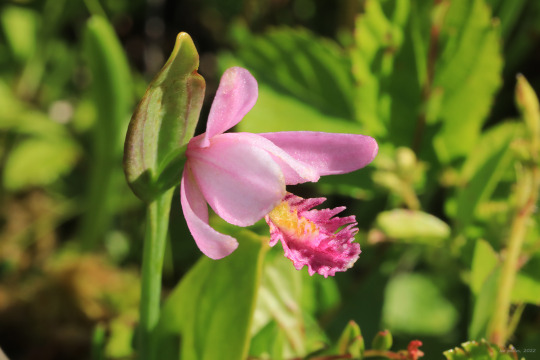
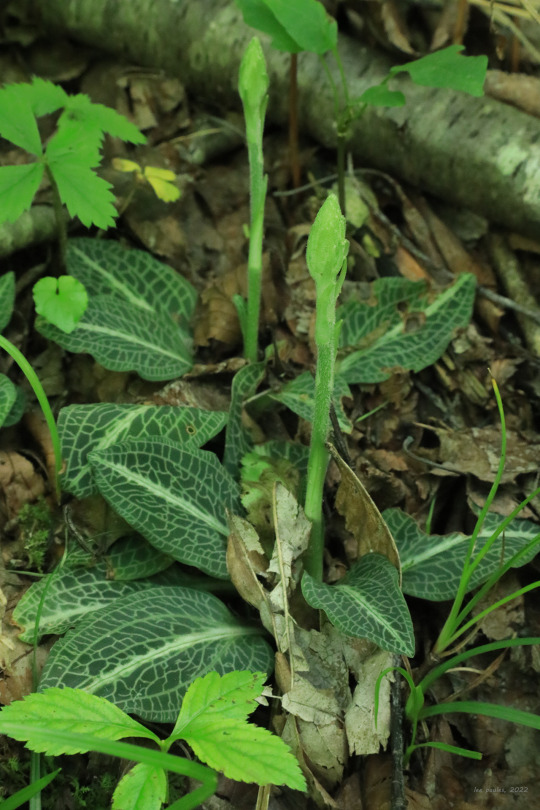

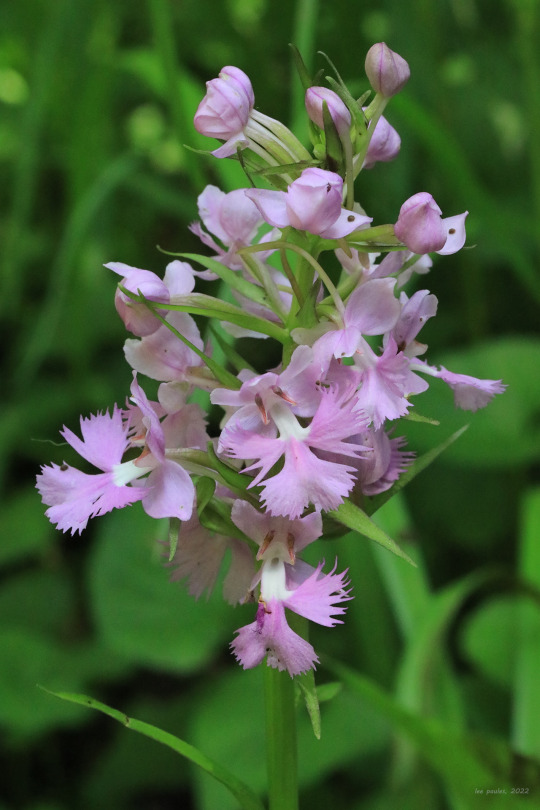

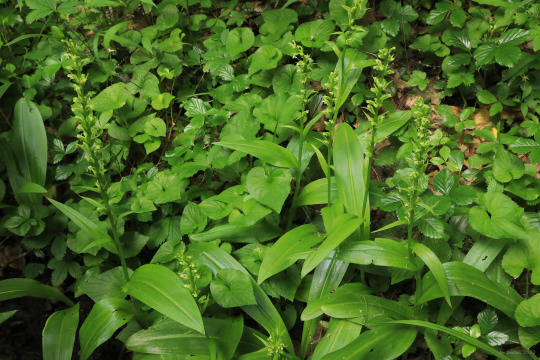

Orchid Collection from Cranberry Glades. From May through September, the high elevation sphagnum bogs and spruce-northern hardwood forests of the Allegheny Mountains produce a steady stream of terrestrial orchids. Prime time orchid season around Cranberry Glades is mid-June through early July, when the showiest orchids hit their peak. As a note, many of these orchids are wetlands-dependent and are endangered or threatened throughout much of their range due to habitat loss.
From top: grass pink (Calopogon tuberosus), unusual among orchids in that its lip is at the top of the flower, making it appear upside down; rose pogonia (Pogonia ophioglossoides), also known as snakemouth orchid due to its elaborate lower lip with pink and yellow-tinged teeth; downy rattlesnake plantain (Goodyera pubescens), a shade-tolerant woodland orchid that was just beginning to send up its flowering stalks; Round-leaved rein orchid (Platanthera orbiculata), or dinner-plate orchid, another terrestrial woodland orchid; large purple-fringed orchid (Platanthera grandiflora), or greater purple-fringed bog orchid, a tall, showy wetlands lover with a special fondness for damp seeps that get full or dappled sunlight; northern tubercled bog orchid (Platanthera flava), or pale green orchid, whose tiny flowers are distinguished by conspicuous bumps (tubercles) on their lower lips; and lily-leaved twayblade (Liparis liliifolia), a very unusual orchid whose flowers mimic the color of carrion to lure flies, which pollinate them.
#appalachia#vandalia#allegheny mountains#monongahela national forest#cranberry glades#cowpasture trail#sphagnum bog#orchidaceae#calopogon tuberosus#grass pink#pogonia ophioglossoides#rose pogonia#snakemouth orchid#goodyera pubescens#downy rattlesnake plantain#platanthera orbiculata#round-leaved rein orchid#dinner-plate orchid#platanthera grandiflora#large purple-fringed orchid#greater purple-fringed bog orchid#platanthera flava#northern tubercled bog orchid#pale green orchid#liparis liliifolia#lily-leaved twayblade#summer#flora#wildflowers
37 notes
·
View notes
Photo
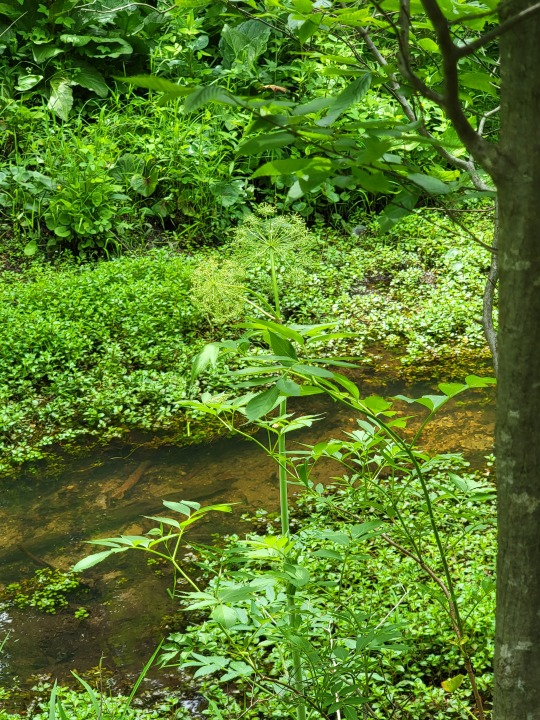
Angelica venosa,
it’s amazing what a change in ph and a bit of tanic acid mixed with iron does to an ecosystem. Along the stream that passes through a section of the white cedar/ black ash tulip poplar swamp. A species more associated with a core habitat of acidic wet meadows of the Allegheny plateau and the adjacent Appalachian mountains finds it’s range limit. These iron seeps and the acidic pools of cedar duff that eventually make tea and leach out through permeable gravel banks create a unique micro habitat, only a few feet deep before meeting alkaline marl. Enough for cation exchange capacity increases, enough for nutrient requirements, enough for this species to somehow grow.

Obviously this species may be under appreciated and under studied in my opinion.
East fork State park has an acidic flat wood meadow. so does warren county. There are plenty acidic flat woods in Indiana near Versailles sp and Madison, big oaks ect. Boone co. KY is green(common) in this map. but not Cincinnati, Is it because our acidic meadow are removed from development or invasives. (maybe) there is still subtle bits of sandstone hiding at the tips of some hills, on road cuts its somewhat visible. Some springs are still lurking in private properties on the edge of Indiana and butler county along the great Miami. The concept of a species range is somewhat nebulous because it’s based on site history, how a seed moves, and the local geology and ecology.
A lot of stuff is like this, I feel like there is romanticism in finding new things and understanding more about the history of the land. I feel like people are quick to become stagnant before realizing how much of the united states is not documented at all.
youtube
This video gave me some strange ideas myself, so i contacted Joey via instagram because i was visiting oklahoma around the same time the phenology of bloom overlaps. ( i look at phenology from i naturalist observations and time of picture) then I checked to overall host ranges and the overall parasitic range on both inat and bonap. oklahoma has the panhandle counties adjacent which have the host species but not any reports on the parasite. the habitat requirements are met. Dalea frutescens as a primary host based on herbarium and i nat reports. Woody species also and scrub forbs closely related like Amorpha spp.
60% of all hosts being Dalea frutescens.
But bonaping dalea, and going through each genus to figure out if some are woody and which ones helps me figure out potential hosts.
I talked with Joey a bit about habitat which helped clarify what I was looking for.
to finalize I start planning a trip based on accessibility to areas via parks.
if you are ever curious about what was in your county, check bonap, i nat, and herbarium records. It can be fun and can benefit the worlds understanding.
#mound fen#ohio#botany#wildflowers#angelica#angelica venosa#ecology#romantacism#discovery#methods#plantblr#oklahoma#herbarium
29 notes
·
View notes
Photo
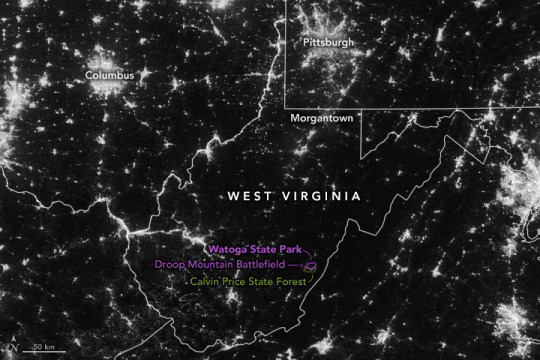


West Virginia’s Dark, Starry Parks Amid the network of artificial lights lights that span our planet like a game of connect-the-dots, darkness is a precious commodity. There are places, however, where the terrain and distance from cities help keep light pollution to a minimum. Watoga State Park in eastern West Virginia is one such place. Watoga and the nearby Calvin Price State Forest and Droop Mountain Battlefield State Park combine to span a total of 31 square miles (80 square kilometers) of Pocahontas County. Located in the highlands of the Allegheny Mountains, the parks are relatively remote—far from the glow of major cities that light up much of the eastern United States. Only a handful of small towns and farms dot the otherwise heavily forested landscape. The remoteness of the area is evident in this nighttime image, which shows the pattern of human settlement across West Virginia. The image was acquired on April 24, 2022, with the Visible Infrared Imaging Radiometer Suite (VIIRS) on the Suomi NPP satellite. The image comes from the VIIRS “day-night band,” which detects light in a range of wavelengths from green to near-infrared and uses filtering techniques to observe signals such as auroras, city lights, and reflected moonlight. The second image (below), acquired on October 18, 2021, with the Operational Land Imager (OLI) on Landsat 8, shows a natural-color view of the parks during the daytime. Recent changes have made the parks even darker than just a few years ago. Mary Dawson and Louanne Fatora, board members of the Watoga State Park Foundation, obtained funding that allowed them to replace existing lights throughout the park with new fixtures that aim downward and use bulbs that cause less light pollution. In addition, volunteer astronomers tracked the quality of nighttime darkness over the span of a year, and the park held several events to educate the public about dark skies. The efforts culminated in all three parks receiving official status as “dark sky parks” in October 2021. They were the state’s first parks to receive the designation from the International Dark-Sky Association. Even designated dark sky parks are not completely dark. Instead, they are lit by natural sources such as starlight and moonlight. The celestial light show draws amateur astronomers, stargazers, and photographers. The photograph below, shot by Jeff Ball, shows the Milky Way over Watoga Lake. The name Watoga is the Cherokee word for “starry waters,” according to the park’s website. While dark skies are favored by stargazers, they are also important for the local ecology. “Watoga’s dark sky designation is just as much about the preservation of habitat for many unique species of animals, plants, and insects, as it is about the clarity of the night sky,” Fatora said. For example, the park is home to the rare “synchronous” firefly. It’s the timing of their flashes—made in rhythmic, synchronized intervals—that sets their mating display apart from other fireflies. Watoga State Park is one of a handful of public locations in the United States where people can view the display. The park’s protection from light pollution should also benefit the fireflies, which are sensitive to light. Visitors should be aware that firefly displays last just a few weeks of the summer, and celestial views are occasionally obscured by clouds. But as West Virginia’s largest state park, Watoga offers plenty of activities, such as hiking, paddling, and swimming, to keep visitors busy until the natural light shows return. NASA Earth Observatory images by Joshua Stevens, using VIIRS day-night band data from the Suomi National Polar-orbiting Partnership and Landsat data from the U.S. Geological Survey. Photograph by Jeff Ball. Story by Kathryn Hansen.
11 notes
·
View notes
Text
“No one knows where it is
We know little but it is known”
—Mak Dizdar
There is one blue river we must cross. I read that in translation. I wondered if it was the Blue Danube. Perhaps it was the Volga, or the Vardar we walked beside in Skopje, among the Roman ruins, where I taught, where we gave the gypsy boy what we had every day so he could buy his tiny sister the pastry and dance his little dance. The joy we felt when his mother returned that winter and we saw her tussle his hair and he was able to go back to doing what older brothers are due. Or the Mississippi in Saint Louis where John was nearly shot trying to score, the bullet casing rang against the dark, or was it the Ohio where old Tony lost his job when the mill closed, he left to no one knows where the river takes us, the same with Timmy and the Allegheny, or was it the Susquehanna, or the Merrimack, alongside the closed down red brick mills, where we drank, where me and my friends would sit beside talking about leaving. Until we did, until we disappeared from that life and into another no one knows where it is. We know little but it is known. Or did I misread those words that were written decades ago in another language, in a country that no longer exists, was it not a blue river but did it say, There is one blue cross we must climb, like the one that rose high on the mountain above that city from another life, or the one we own inside our chests. How we make the sign when we touch our foreheads and our hearts, beyond foreboding beyond doubt, when we kneel and pray, we bow our faces to the dirt of our dead and offer the sky the nape of our blue veined necks.
—Sean Thomas Dougherty, “There Is One Blue River” (Not All Saints, The Bitter Oleander, 2020)
#poetry#prose poetry#sean thomas dougherty#rivers#loss#memory#prayer#this fucking poem#not all saints#currently reading#g slur tw
3 notes
·
View notes
Note
What is like to live in Arizona?
I’m not gonna lie the heat is ridiculous even though it’s a dry heat. But I absolutely despise snow, so being in Southern Arizona is a treat because we only get really cold for like a week or two in the winter and the rest of the winter is super mild.
The Sonoran Desert is SOOOO pretty. I feel like most people hear desert and think it’s dusty and brown and dead, and yeah it’s sometimes those things, but oh my god it’s so green too? Saguaro are just amazing and impressive with what they can withstand. The fact that so many plants survive in this weather is astounding.
Then there’s the mountains???? I spent a lot of my childhood in and around the Appalachian Mountains and Allegheny Mountains in Pennsylvania, but the mountains out here put them to shame. Like I can walk outside my house and see a different mountain range every direction I turn. It’s been two years but sometimes I walk out of a store at the right time in the evening when the sun is setting and it hits a mountain range just right and I’ll be like “oh my god this place is beautiful can you believe we live here?”
5 notes
·
View notes
Text
The History of Lexington KY
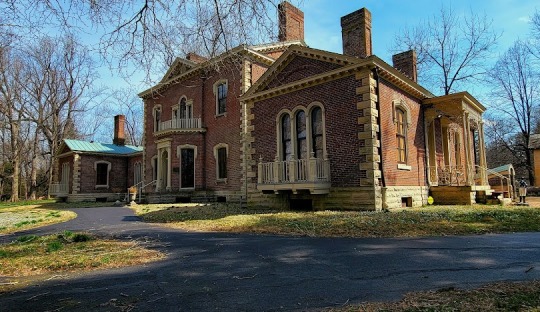
Lexington, Kentucky is a city with a rich and storied history. Founded in 1779, the city was one of the first to be established west of the Allegheny Mountains. It was named after the Battle of Lexington, which had occurred just four years earlier in Massachusetts, marking the start of the American Revolutionary War.
In its early years, Lexington was a hub of activity and growth. It quickly became a center of commerce, education, and culture in the region. The city was home to the first newspaper west of the Alleghenies, as well as the first theater. Transylvania University, founded in 1780, is one of the oldest institutions of higher education west of the Appalachian Mountains.
Lexington's prosperity continued through the 19th century. It became known as the "Athens of the West" due to its reputation for education and culture. The city was a leading producer of hemp, which was an important crop at the time. Lexington was also a center of the thoroughbred horse breeding industry, an association that continues to this day.
During the Civil War, Lexington was a contested city, changing hands between the Union and Confederate armies several times. This led to much destruction and hardship for the city's residents. However, Lexington was able to recover in the years after the war.
In the 20th century, Lexington continued to grow and evolve. It became a hub for the automotive industry, with several major manufacturers establishing plants in the area. The University of Kentucky also expanded significantly during this time, becoming a major economic and cultural force in the city.
Today, Lexington is a thriving city of over 322,000 people. It has a diverse economy, with strengths in sectors like healthcare, technology, and of course, the equine industry. The city retains its reputation for education and culture, home to several colleges and universities as well as a vibrant arts scene. Lexington's history has shaped it into the dynamic community it is today.

Arborists are the dedicated professionals who care for the health and well-being of trees. They are the tree doctors, diagnosing problems, recommending treatments, and performing necessary procedures to keep trees healthy and thriving.
Much like human doctors, arborists require extensive knowledge and training. They possess a deep understanding of tree biology, physiology, and ecology. They can identify different tree species, diagnose diseases and insect infestations, and recommend appropriate treatments. Additionally, they are skilled in pruning, cabling, and bracing trees to improve their structure and stability.
Arborist play a crucial role in maintaining the health and beauty of our urban and natural environments. Trees provide numerous benefits, including shade, oxygen production, carbon sequestration, and habitat for wildlife. By caring for trees, arborists help to ensure these benefits are enjoyed by present and future generations.
Here are some of the key tasks performed by arborists:
Tree assessments: Inspecting trees for signs of disease, insect damage, or structural problems.
Pruning: Removing dead, diseased, or weak branches to improve tree health and structure.
Cabling and bracing: Installing cables and braces to support weak or damaged branches.
Planting: Selecting and planting appropriate tree species for specific locations.
Fertilization: Providing trees with essential nutrients to promote growth and health.
Disease and insect control: Identifying and treating diseases and insect infestations.
Tree removal: Removing trees that are dead, diseased, or pose a safety hazard.
If you are concerned about the health of your trees, consider consulting a certified arborist. They can assess your trees, recommend appropriate care, and help you keep them healthy and beautiful for years to come.
Robinson Tree Service is proud to employ certified arborists who are dedicated to providing the highest quality tree care services. We offer a wide range of services, including tree pruning, removal, planting, and disease and insect control. Contact us today to schedule a consultation with one of our experienced arborists.
Robison Tree Service
105 Summer Ridge Rd, Mt Sterling, KY 40353,
859-644-4874
http://www.robisontreeservice.com/
youtube
0 notes
Text
The right of way formed a twisting ledge between rock cuts on one side and white water rapids far below on the other. Melting snow and changing temperatures exacerbated fissures in the rock, periodically causing huge boulders to come crashing down onto the tracks. Mountain railroads employ slide fences that electronically warn trains that tracks may be fouled by falling rock, (or trespassing deer). Equipping an entire route through a mountain range, however, is cost-prohibitive.
Descending westbound, into Connellsville, Penn., one dark 1988 night, negotiating 30 mph Number One Cut, I suddenly spied a boulder the size of an automobile, wedged between the hillside and the rails. With a collision inevitable, I applied the emergency brake and radioed my conductor, “Get everybody down and hold on — we’re gonna hit a big rock!“ And we did.
I feared a glancing blow off the side of the boulder, derailing and fouling the adjacent track, or even plunging the entire train into the river below, but we remained upright and on the track. My fireman, Dave, headed out to protect us from oncoming trains, while I got on the radio to warn any trains in the area, “Emergency, Emergency! Amtrak 29 is in emergency at Number One Cut!” Radios aren’t very effective in the mountains so out of pure frustration I shouted into the handset, ‘Mayday, Mayday! Can anyone hear me?”
My lead F40, was rendered useless by the collision with most of its air brake equipment torn away. Standing atop the boulder, adjacent to the dining car, conductor Jerry surveyed the damage. “More rock is falling. We’ve got to move this train right now!” I blocked the brake pipe flow behind the crippled locomotive, placed my fireman at its handbrake, and my conductor served as my set of eyes in the cab, while I operated the train from the second unit. Without further incident, we limped into Connellsville. “You’re supposed to say ‘Emergency,’ not ‘Mayday,’” chirped the tower operator. Everyone had heard my transmission — they just hadn’t responded.
I retired in 2012. My son, Ryan, now 39, has 20 years of Amtrak service and is a regularly assigned engineer on the Capitol Limited between Washington and Cumberland, Md. He called me on his way home recently. “I hit a boulder at Paw Paw, [W.Va.] eastbound this morning, bigger than the one you got. I managed to stay on the rail though. Everyone’s okay, but it tore up the engine.” Then, he paused …
“I got into Washington just in time to catch 85 to Richmond. Jerry was the conductor. When he asked why we were so late, I explained that we’d hit a boulder. With a huge grin on his face, he said, “Like father, like son.” Then he asked, “Did you yell ‘Mayday, Mayday’ too?”
0 notes
Text
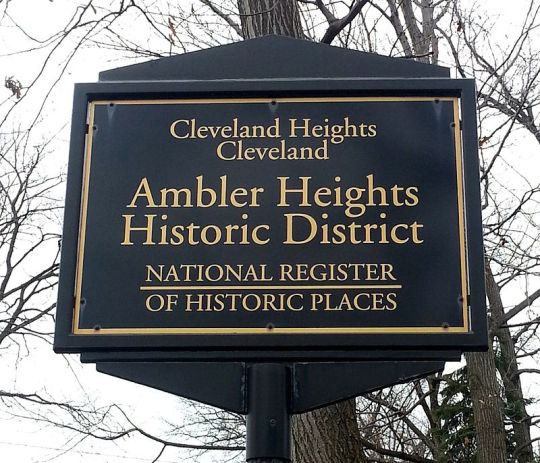

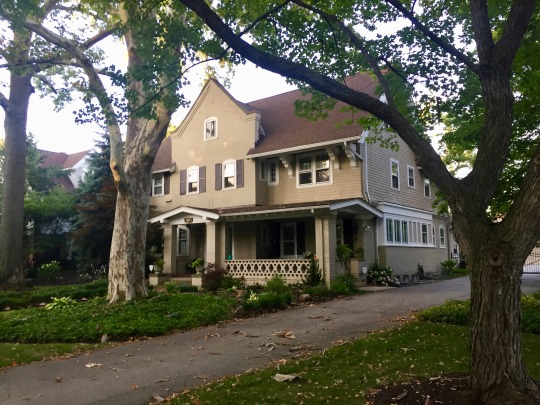

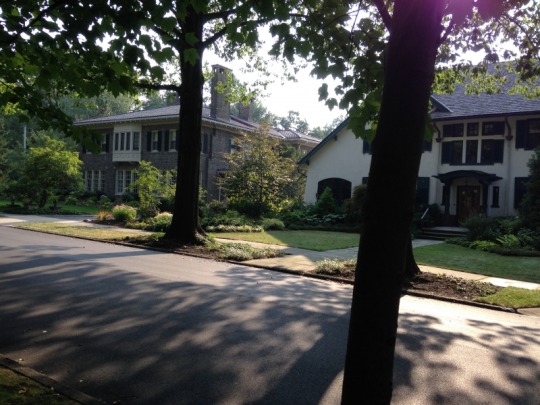

Ambler Heights Historic District
Harcourt Dr.
Cleveland Heights, OH
Ambler Heights Historic District is a historic district in Cleveland Heights, Ohio, roughly bounded by Martin Luther King Jr. Boulevard, Cedar Glen, N. Park Boulevard, and along Harcourt Dr Listed on the National Register of Historic Places in 2002, it includes 112 contributing buildings in an area of 73 acres, which was created between 1903 and 1927. The Ambler Heights Historic District is an early twentieth century suburban residential development platted in its current form in 1900. Development began about 1903 and was largely completed by 1927. The District is located mostly in the southwest corner of Cleveland Heights, Ohio, an inner-ring suburb of Cleveland; a small portion of the District is located within the boundaries of the City of Cleveland. It is an example of the successful marketing of “garden city” living to the wealthy during the first stage of the suburbanization of Cleveland.
The area consists today of 66 original, single-family, architect-designed private homes, one original home which has been converted to use by a retirement community (but continues to be a contributing resource) and 14 non-contributing homes. The original homes and the District are well-preserved and have experienced relatively little alteration since their construction; they therefore may be said to have integrity. The District is located approximately five miles east of downtown Cleveland. Bounded by Cedar Glen Parkway (north), South Overlook Road (east), North Park Boulevard (south) and Ambleside Road and Martin Luther King, Jr. Boulevard (west), it is located on the rise of a gradual hill leading from the City of Cleveland at its lower elevation to the various “Heights” suburbs (including Cleveland Heights and Shaker Heights) at its higher elevations; this ledge of land forms the western limits of the Portage escarpment of the Allegheny Mountains.
The Ambler Heights area is named after Dr. Nathan Hardy Ambler (1824-88), a dentist who amassed considerable wealth during the California Gold Rush and subsequently entered into real estate development in Cleveland. Originally farmland, Ambler Heights began to be developed about 1903 by Dr. Ambler’s adopted son, Daniel O. Caswell, and his nephew, William Eglin Ambler. Gracious homes of 2, 2-1/2 and 3 stories, ranging in scale from about 3,000 to more than 8,700 square feet, were built to the specifications of some of Cleveland’s leading families and designed by well-known architects of the period. They mostly exhibit period revival styles such as Colonial Revival and Tudor Revival, but often in interpretations typical of the Progressive Era. As a whole, they consistently exhibit characteristics typical of upper-class domestic suburban architecture of the time. The district was added to the National Register of Historic Places on August 22, 2002.
0 notes
Text
Popular Hiking Destinations in New York State

Nearly 59 million Americans went hiking at least once in 2021, while 10.3 million people embarked on a backpacking excursion, according to results from the 2022 Outdoor Participation Trends Report released in March 2023. There is a wide range of physical and mental health benefits associated with hiking, from improved muscle and bone strength to decreased levels of stress and anxiety. Hiking enthusiasts in the state of New York have a number of popular hiking areas to choose from, including the Catskill Mountains, Lake Placid, the Finger Lakes, Bear Mountain State Park, and Watkins Glen State Park.
The Catskill Mountains are located in the southeastern part of the state between Albany and New York City. Encompassing some 700,000 acres, the region provides thousands of miles of diverse hiking trails. Families with young children can find plenty of quiet trails winding peacefully through the forests, while more adventurous hikers can take on the Catskill 3500 Club, which consists of 33 climbs all exceeding 3,500 feet in elevation. Popular trails include Giant Ledge, a moderately challenging climb that provides some of the most sweeping views in the Catskills, and the Ashokan Rail Trail, an 11.5-mile trail compliant with Americans with Disabilities Act standards.
Lake Placid is a village in the Adirondack Mountains known as the host of the 1932 and the 1980 Winter Olympics and the home of the 2,170-acre lake of the same name. In addition to various aquatic activities in and on the lake, hikers can take advantage of the 20-plus miles of challenging terrain, not to mention additional hiking locations throughout the Adirondacks. Like the Catskills, Lake Placid maintains an informal club for hikers interested in taking on the region’s 46 iconic peaks. That said, there are a number of trails better suited to families and hikers more interested in relaxing and taking in the scenery.
The Finger Lakes are a five-hour drive not just from New York City, but nearby metropolitan hubs such as Washington, DC, Boston, and Philadelphia, making it an attractive destination for hikers throughout the Northeast. The trail system features more than 1,000 miles of trails, including the 950-mile-long Finger Lakes Trail (FLT). The FLT begins in Allegheny State Park at the border of Pennsylvania and runs into the Catskill Forest Preserve. Backpackers can extend the route to Niagara Falls, the Great Eastern Trail, and other multi-day treks.
Bear Mountain State Park is situated alongside the Hudson River. The park consists of dozens of trails for hikers of various skill levels, from the moderate 3.8-mile Bear Mountain Loop Trail to the challenging Perkins Memorial Tower climb, which takes most hikers over two hours to complete despite spanning just 3.4 miles. The Perkins Memorial Tower route provides hikers direct access to the Appalachian Trail.
Finally, Watkins Glen State Park is a park in the Finger Lakes region. Hikers can visit parks.ny.gov and download a trail map. The map includes recommended hikes that guide hikers to 19 waterfalls. Trails include straightforward paths like Lover’s Lane as well as more challenging climbs, such as Jacob’s Ladder and the North Rim Trail.
0 notes
Text
Best Travel Destinations in the North American Country
The Northeast United States has many beautiful places to visit if you enjoy the outdoors. In addition, there are numerous undiscovered wonders to be discovered, from lakes to ice caves. In the U.S. North, you can find the ideal location for anything from a leisurely lakeside holiday to a hiking and fishing trip. Here are some of the top destinations in the Northeast area. Listed here are just a few of our top vacation spots:
The Allegheny National Forest has all you need for an enjoyable camping trip in the woodlands of New York, Pennsylvania, or New Jersey. Camping trips, cottage, or cabin rentals are great ways to see this area's natural beauty. Even swimming is permitted in the region's crystal-clear waters. On your next trip to the Allegheny National Forest, there are many enjoyable activities if you enjoy the beach.
Another fantastic location for outdoor enthusiasts is the Colorado Rockies. Numerous beautiful villages and great hiking paths may be found here. You can still be in the wilderness for a few days by finding the ideal base camp for a road trip. You can also travel to Alaska's mighty Tenmile Range for an adventure. There are a few other places that are also quite worthwhile a visit.
Other national parks in the northern United States include the Grand Canyon and Yellowstone. Each year, Glacier National Park welcomes thousands of visitors. In Montana, Whitefish is a charming town surrounded by mountains. You can also rent a car if you own one. You may ski or snowboard in the park throughout the winter. You can have a picnic in the town of Whitefish throughout the summer.
New Hampshire is a fantastic destination for a family vacation. The White Mountains are a breathtakingly beautiful landscape, and a thriving community of tourism-related enterprises embraces the area. You can kayak, zip line, or go tubing in addition to going on a moose safari. The Cog Railroad will take you to Mount Washington as well. You can use the Canon Mountain Aerial Tramway at Franconia Notch State Park if you'd like a more picturesque route. Along the Falling Waters Trail, you can hike to waterfalls.
The history and natural beauty of the Outer Banks are well known. The Outer Banks is ideal for a beach vacation if you enjoy the beach. The numerous attractions are conveniently close to the towns. The Outer Banks have plenty to offer everyone, regardless of your interest in art or history. You're sure to find an attraction that suits you, from hiking to kayaking.
The Great Basin National Park in Nevada is rarely visited, close to the Utah border. However, the park's Lehman Caves are a highlight, so make a reservation before going. The Lehman Caves have stalactites and other limestone formations. You will be in awe of this beautiful area whether you travel by vehicle or bus.
Atlantic Beach is one of the underappreciated beach communities in the U.S. Atlantic Beach, located on the North Carolina coast, is a secret treasure. This small town's picturesque surroundings make it the perfect place to unwind. In addition, views of the entire city are available to visitors at the tower's summit. In the end, this beach town is well worth a trip. It's also among the top destinations on the North American continent for travel.
Be sure to go to Washington, D.C., for the cherry blossom festival! The city is awash in cherry blossoms during the Tidal Basin and looks just stunning. The weather is ideal for going for a stroll—many museums in the city, including the Smithsonian Museums and those honoring the numerous former presidents. Of course, you will need to schedule your trip around the Cherry Blossom Festival.
1 note
·
View note
Text
"...and bears, oh my!"
Life in the woods, birds, butterflies, trees and sunshine. And bears!
Hello, cutie-pie. (Not my photo.)
We’re spending the summer volunteering at a state park. A lot of folks are unaware that Maryland extends west to the Appalachian plateau. Properly speaking, Garrett County, were we’re living this summer, lies in the Allegheny Mountains, which form the western flank of the Appalachian Mountain Range. They’re called mountains. Frankly, they’re more hills, lovely…
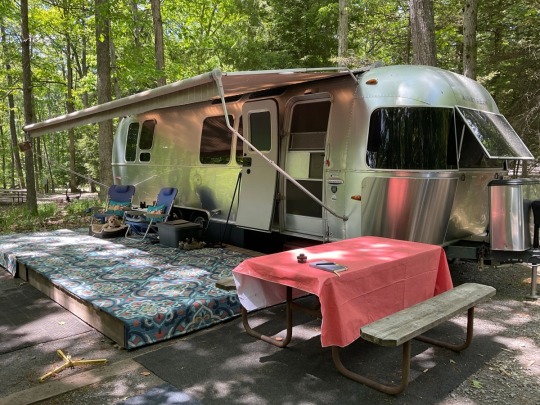
View On WordPress
1 note
·
View note